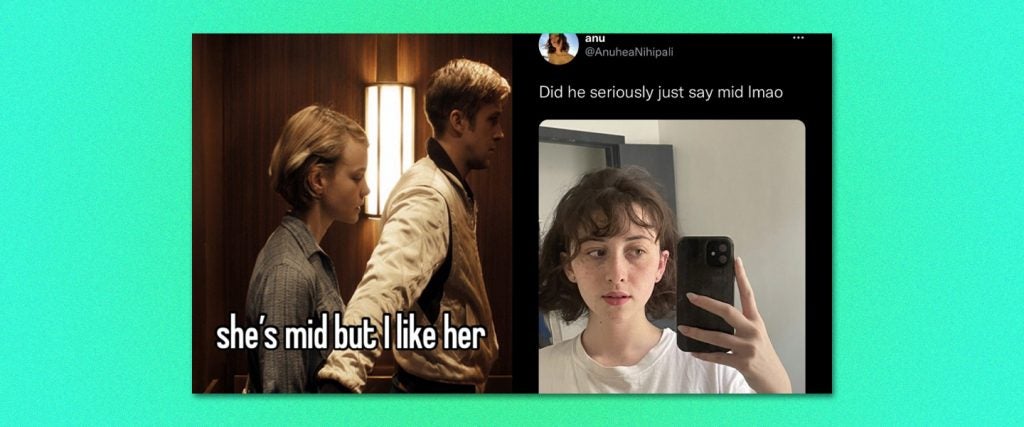It is a truth no digital native would deny: Some people you start following because they’re hot, and you’d like to see more of them. No harm, no foul. Besides, there are always other reasons to appreciate a hottie. They’re fun, witty, show off a cool talent or share their expertise. Sometimes they’re like the rando you connect with at a party, someone who matches your vibe and banter. In time, you may forget it was a thirst trap that initially caught your eye.
There is, nonetheless, a dark side to mentally sorting countless internet strangers by their looks. If you get too humorless about the practice, you could wind up mired in a cringey comment war over who should be regarded as “mid” — i.e., visually middling, mediocre, a 4 to 6 on the trashy but inescapable 10-point scale of attractiveness. The dating-pool equivalent of mids, or cannabis that isn’t especially potent. It’s a word to dismiss the average, the okay, the nothing-to-write-home-about. And while it’s one thing to refer to a rap verse or fast-food sandwich as “mid,” dropping it on a person is in some ways nastier than calling them “ugly.” The latter can be read as knee-jerk hate; the former is perversely tame, a room-temperature insult. It’s a spiritual heir to “basic,” so broadly all-encompassing that nobody can hope to escape it.
Recently, Hawaiian podcaster and popular TikTok creator Anuhea Nihipali reacted to an objectifying meme that described them as mid, which set off a wave of discussion around the term. A good deal of this, unfortunately, proceeded from the basis of the meme itself — that anyone who has shown their face or body on the internet must accept public debate on their ranking in an imagined sexual hierarchy. As Nihipali pointed out, “positive” attention in this regard can be as gross as a bunch of anonymous trolls agreeing that you’re mid. They were especially annoyed by replies asking if they might start an OnlyFans account, which felt like another angle to the same harassment, as though they could either serve an erotic fantasy or submit to disparagement for not living up to that ideal, but had no agency nor value otherwise.
Even before Nihipali went up against their haters, social media at large was wrestling with the pernicious meanings of “mid.” Two strains of usage dominate. The first targets specific women or individuals perceived as femme, and it always reads as sour grapes: You’ll never be with her, and indeed never had the opportunity, but calling her mid makes it sound like you made that choice and did the rejecting. This variant of “mid” also relies on the misogyny stirred by a woman’s healthy self-esteem. If you notice she’s happy with her appearance and sharing it as a result, a certain dude-logic goes, then she’s forgotten her place, overestimated her appeal and should be cut down to size. Hence that brain-dead “the internet convinced women they’re all supermodels” gripe. Do women really think that, or are they… occasionally posting selfies?
The category of “mid” guys, however, appears too vast for individual case studies. Those attracted to men and the masc-presenting instead refer to the group as a whole, rarely impugning any one person as mid unless he’s a celebrity with a legion of stans lusting after him. Curiously, whereas “mid” women and nonbinary folks are implicitly understood as single or available due to their alleged status (or, sometimes, their indifference to gender norms and archetypes), “mid” cishet men are routinely criticized for pulling partners above their league. The dominant stereotype is a puzzling relationship in which a very hot, successful woman or nonbinary person has pinned their hopes on a bland fellow with few redeeming qualities or prospects. Except, then, there are some who claim to prefer mid guys to the stresses of dating the stunningly handsome. If you like, you can even embrace the rating of “mid,” thereby ejecting yourself from the discourse altogether.
It’s true that Instagram and the like have fueled an anxiety of image — how can we compete with the professionally gorgeous? But, at the same time, social media has allowed for the validation of bodies and faces you might not see represented otherwise; we have the freedom to flaunt and admire, as in real life, “ordinary” beauty, without the touch-ups and meticulous staging. The kind of direct allure that recognizes how any “perfect 10” is a cultural construct, not a fact of nature. The focus on mid aesthetics, which emerged from these contradictory trends, is a way of having everything at once in a fluid and confusing space — project your insecurity by trying to instill it in someone else, neg them as unworthy of attention while dogging their replies with unsubtle sexual interest, demand a continuous stream of new images and subjects so that you can keep finding fault, forever.
I’m sure it passes the hours, though as a lifestyle? It’s pretty mid.

